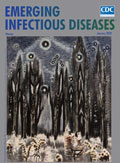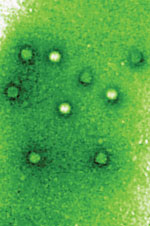
Volume 26, Number 1—January 2020
Etymologia
Etymologia: Picobirnavirus
Figures
Downloads
Article Metrics
Picobirnavirus, the recently recognized sole genus in the family Picobirnaviridae (Figure), is a small (Pico, Spanish for small), bisegmented (bi, Latin for two), double-stranded RNA virus. Picobirnaviruses were initially considered to be birna-like viruses, and the name was derived from birnavirus (bisegmented RNA), but the virions are much smaller (diameter 35 nm vs. 65 nm).
Picobirnaviruses are reported in gastroenteric and respiratory infections. These infections were first described in humans and black-footed pigmy rice rats in 1988. Thereafter, these infections have been reported in feces and intestinal contents from a wide variety of mammals with or without diarrhea, and in birds and reptiles worldwide.
References
- Delmas B, Attoui H, Ghosh S, Malik YS, Mundt E, Vakharia VN; Ictv Report Consortium. ICTV virus taxonomy profile: Picobirnaviridae. J Gen Virol. 2019;100:133–4.
- Malik YS, Kumar N, Sharma K, Dhama K, Shabbir MZ, Ganesh B, et al. Epidemiology, phylogeny, and evolution of emerging enteric Picobirnaviruses of animal origin and their relationship to human strains. BioMed Res Int. 2014;2014:
780752 . - Pereira HG, Flewett TH, Candeias JA, Barth OM. A virus with a bisegmented double-stranded RNA genome in rat (Oryzomys nigripes) intestines. J Gen Virol. 1988;69:2749–54.
- Smits SL, van Leeuwen M, Schapendonk CM, Schürch AC, Bodewes R, Haagmans BL, et al. Picobirnaviruses in the human respiratory tract. Emerg Infect Dis. 2012;18:1539–40.
Figure
Cite This ArticleOriginal Publication Date: 12/4/2019






















.jpg)












No hay comentarios:
Publicar un comentario